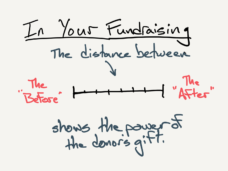Our last post was about how the distance between the “before” and the “after” shows the donor the power of their gift.
Speaking of this, I’ve noticed that there are four different ways organizations tend to handle “before’s and after’s,” and each results in different fundraising results…
Only the “Before”
Organizations that share only the “before” – the need that exists in the world before your organization has helped – will raise a lot of money in the short term.
But these organizations have troubles keeping their donors, because their donors never see or feel what their gift accomplished.
This short-term success can be extended to medium-term and even long-term IF the organization has a fantastic donor acquisition program and works on an issue with broad appeal. But it’s not a good strategy for smaller organizations – and I don’t think it’s particularly honoring to beneficiaries or donors.
Only the “After”
If organizations only share the “after” – the positive state after the organization has done its work – the organization will raise less money than it could be raising.
Some donors are motivated just by hearing the “after.” But a lot more donors are motivated by hearing the “before” and the “after.” When the “before” is never shared, a significant percentage of people don’t give, or give less.
A secondary consequence of only sharing the “after” is that organizations accidentally hide the need faced by their beneficiaries.
No “Before” and No “After”
If you share no “before” and no “after,” you also raise less money. This happens when a nonprofit tells donors that the work is happening now, that the work will continue, and asks the donor to “continue to” support the work. There’s no “before.” There’s no “after.”
These organizations accidentally communicate to donors that no change happens when the donor gives – so why should the donor give?
I hope it’s obvious that “why should the donor give?” is a rhetorical question, because the nonprofit is presumably doing good work. This post makes the case for why asking a donor to “continue to” support an organization’s work is one of the least compelling ways to ask for support.
“Before” AND “After”
The organizations where we’ve seen the greatest fundraising success share both the before and the after. They share the bad news and the good news.
When Asking in appeals and e-appeals, they share what’s happening now (the “before”) and what will happen if the donor gives a gift (the “after”).
When Reporting in newsletters, they share what was happening (the “before”) and what’s happening now (the “after”).
The constant contrasting of the “before” and “after” helps a donor see how big an impact their gift to your organization can make, or has made in the past. This is the best strategy, and it provides a strengthening blend of short-term and long-term success.
This strategy honors beneficiaries because it creates awareness of the current situation and of the hopeful future that’s possible. It honors donors by showing them the impact of their generosity.




2 comments on “Before’s & After’s”